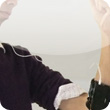
Year: 2008-10
Member:
Yasunori Tsubouchi
Hideki Kadone
Kenji Suzuki
Partners:
Masaki Iguchi (Tsukuba University of Technology)
Masaki Matsubara
Yoko Terasawa
(Univ. Tsukuba)
Tags:
- Cybernics
- Augmented Human
- Emerging Technologies
|
|
bioTones
A wearable auditory bio-feedback device
|
|
|
|
From the point of view of support for motion and locomotion, it is important to not only physical power assistance but also cognitive assistance in terms of visual, auditory and haptic feedback. In recent years, there have been some reports about exoskeleton type power assisting robots, which aim to assist human movement physically by using robotics and computational methods. On the other hand, there are some reports of what can be called cognitive assistive devices, for example the tactile contact lens to amplify the sense of touch. In the field of physical medicine, rehabilitation, and body training, an important way of cognitive assistance is the EMG real-time feedback. Several studies have been made on apparatuses which use EMG. In the past few years, various efforts have been made to measure and visualize human motion by utilizing electrophysiological techniques or motion capture. However, those systems usually require large space or special equipment available only in a limited areas.
We have been developing a wearable device for EMG based auditory feedback called bioTones. The basic concept of bioTones is to provide cognitive assistance by converting the EMG signal into a sound signal. There are some studies on the sound generation / sonification from EMG signals in the field of computer music. Some biomedical studies employed EMG feedback delivered in the auditory mode for physiological indicator. However, they haven focused very little on the kinds of the sound and the usability as a device. We thus propose a useful wearable tool which is available even in daily life, based on the auditory biofeedback method. This is a compact and light-weight wearable device for EMG auditory feedback. The device, bioTones, has single channel differential electrodes placed on the under side of bioTones, towards the skin. This novel technology can be of the assistance to preventive healthcare, rehabilitation, sports training among others.
the sound conversion with varying loudness, frequency or rhythm conversion can be used as an alternative to solve the complexity of showing several muscle activities simultaneously, which is not easy by common visual biofeedback. The system can be extended for multiple channels auditory biofeedback. We consider putting multiple bioTones on the body and listening in parallel to multiple channels. We have already developed a device with a built-in speaker. Multi-channels could be implemented by giving each device with a different pitch by using loudness conversion.
|
|

This study was supported in part by the Global COE Program on "Cybernics: fusion of human, machine, and information systems.”
|
| |
|
|
|
Publications
- Iguchi, M., Matsubara, M., Kadone, H., Terasawa, H., and Suzuki, K., "How is Auditory EMG Biofeedback Effective For Blind People?," Proc. of the 19th International Conference on Auditory Display (ICAD-2013), pp.307-310, 2013.
- Matsubara, M., Terasawa, H., Kadone, H., Suzuki, K., and Makino, S., "Sonification of Muscular Activity in Human Movements Using the Temporal Patterns in EMG," Proc. of Asia Pacific Signal and Information Processing Association, pp. 1-5, 2012.
- Tsubouchi, Y., and Suzuki, K.: "Biotones: A Wearable Device for EMG Auditory Biofeedback," Proc. of Annual International Conference of the IEEE EMBS, pp. 6543-6546, 2010.
|
|
|
| |
|
|
|
Related Projects
Cybernics / Augmented Human
|
|
|
|



